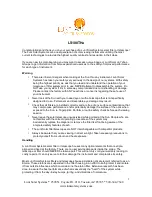
2
ASSEMBLY INSTRUCTIONS
1.
Remove the tripod legs (#16) from the box and separately extend them to suitable length from
top to bottom. Tighten the locking knobs.
2.
Connect each leg to the mount base (#15) with the long screw and wing nuts (Pg. 4, Fig. 2a), but
do not tighten yet. Make sure the accessory tray brackets on each leg are on the inside.
3.
Stretch out the tripod legs and position the accessory tray (#17). Connect each accessory tray
bracket to the tray using the short screws and wing nuts (Pg. 4, Fig. 3).
4.
Install the pitching shaft (#13) on the main tube (#14) with the pitching shaft screws (#4) (Pg. 4,
Fig. 2b).
5.
Loosen the left and right blocks (#12) on the main tube (#14), install the main tube on the main
mount (#2). Tighten the right and left blocks (#12) (Pg. 4, Fig. 2c) and the pitching clamp handle
screw (#11) (Pg. 4, Fig. 2d).
6.
Remove the thumb nuts for finder scope (#6). Insert the two bolts in the finder scope bracket
(#7). Tighten thumb nuts (#6) to mount bracket onto main tube (Pg. 4, Fig. 4a).
7.
Place eyepiece in the focusing tube (#10) and tighten the thumb screw (Pg. 4, Fig. 4b).
READ CAREFULLY BEFORE ATTEMPTING TELESCOPE OBSERVATIONS
A telescope is an optical and mechanical instrument of great precision. Handled with care and respect, it
will provide many years of excellent service. This booklet is designed to furnish you with information on
this telescope’s structure, specifications and proper operating techniques.
WHAT IS A TELESCOPE?
A telescope is an optical system designed to magnify distant objects. The telescope you have purchased
is called a REFLECTOR TELESCOPE, it consists of an open tube with curved mirror at the bottom. The
open end of the tube is pointed at the object in the sky and the entering light rays strike the mirror at
the bottom. The rays, reflected from the mirror, strike a secondary mirror called a diagonal mirror. As a
result of the curvature of the main mirror, the light rays are bent to meet at a point. The purpose of the
diagonal mirror, which is located a short distance before the focal point, is to reflect the light rays
toward the side of the tube where an eyepiece magnifies the image for you.
MAINTENANCE OF THE TELESCOPE
As a precision optical and mechanical instrument, the telescope must be handled with utmost care.
When not in use, store it in the box. Lenses and mirrors must be cleaned as carefully and rarely as
possible to avoid accuracy and performance being affected. Optical elements must never be taken out
of their mount by an inexperienced person. When it becomes necessary to clean the lenses or mirrors, a
cleaning solution, no stronger than mild soap and water, in combination with a soft, lint-free cloth
should be gently applied to the optical surface without rubbing. A thorough rinse in clear water should
follow and the optical element is not rubbed dry, but allowed instead to air dry. The use of solvents such
Summary of Contents for FirstView
Page 4: ...4 ...














